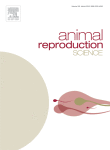Ver ítem
- xmlui.general.dspace_homeCentros Regionales y EEAsCentro Regional Salta - JujuyEEA Abra PampaArtículos científicosxmlui.ArtifactBrowser.ItemViewer.trail
- Inicio
- Centros Regionales y EEAs
- Centro Regional Salta - Jujuy
- EEA Abra Pampa
- Artículos científicos
- Ver ítem
Effect of GnRH analogue administration on Day 7 after natural mating on formation accessory corpus luteum, progesterone concentration and conception rate in llamas (Lama glama)
Resumen
The objectives of the present study were to determine the effects of exogenous GnRH administered7 days after breeding on the formation of an accessory corpus luteum (ACL), plasma progesterone(P4) concentrations and pregnancy rates. Adult females (n=71) having a follicle≥ 7mm in diameter in the ovary were naturally mated (Day 0). On Day 7, ultrasonicexamination was performed to confirm the occurrence of ovulation as evidenced by presence o an induced
[ver mas...]
The objectives of the present study were to determine the effects of exogenous GnRH administered7 days after breeding on the formation of an accessory corpus luteum (ACL), plasma progesterone(P4) concentrations and pregnancy rates. Adult females (n=71) having a follicle≥ 7mm in diameter in the ovary were naturally mated (Day 0). On Day 7, ultrasonicexamination was performed to confirm the occurrence of ovulation as evidenced by presence o an induced corpus luteum (ICL). Females with an ICL plus a dominant follicle≥7mm (n=56) were treated with saline solution (SS, n=29) or GnRH analogue (n=27). On Day 14, the formation of an ACL was observed by ultrasonography. Blood samples were collected on Days 7 and 14 to quantify plasma P4 concentrations. On Day 14, 21 of 27 (77.8%) females in the GnRH group developed an ACL, whereas females in the SS group did not. Progesterone concentrations on Day
7 and 14 in those llamas diagnosed as pregnant on Day 30 were not different (P > 0.05) between groups. In addition, P4 concentration was similar for GnRH-treated females having two CL to those with a single CL. Pregnancy rates were similar (P > 0.05) between SS and GnRH groups
(55.2% compared with 74.1% respectively) and the pregnancy rate for the GnRH group was notaffected (P > 0.05) by the number of CL observed at Day 14 (66.6% and 75.6% for females with one and two CL respectively). In conclusion, GnRH administration on Day 7 after breeding leads to ACL formation; however, neither the plasma P4 concentration nor pregnancy rate was affected by having an ACL.
[Cerrar]

Fuente
Animal reproduction science 190 : 47-52. (March 2018)
Fecha
2018-03
ISSN
0378-4320
Formato
pdf
Tipo de documento
artículo
Palabras Claves
Derechos de acceso
Restringido
 Excepto donde se diga explicitamente, este item se publica bajo la siguiente descripción: Creative Commons Attribution-NonCommercial-ShareAlike 2.5 Unported (CC BY-NC-SA 2.5)
Excepto donde se diga explicitamente, este item se publica bajo la siguiente descripción: Creative Commons Attribution-NonCommercial-ShareAlike 2.5 Unported (CC BY-NC-SA 2.5)

